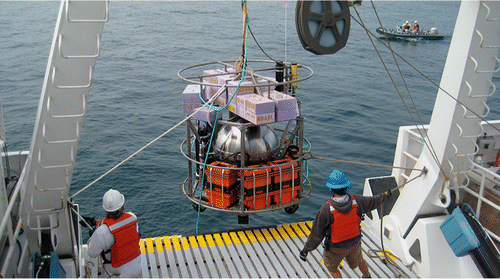Successful deployment of an autonomous deep-sea explorer to search for new forms of microbial life

Scientists are reporting "a significant step forward" in proving the feasibility of launching fleets of autonomous robots that search Earth's deep oceans for exotic new life forms. Their description of successful deployment of the trailblazer for such a project—an autonomous seafloor lander equipped with a mini-laboratory the size of a kitchen trash can that is able to detect minute traces of DNA in the deep oceans—appears in ACS' journal Environmental Science & Technology.
William Ussler III and colleagues note that exotic forms of life may still remain undiscovered around the methane vents in the deep ocean floor that already have yielded previously unknown albino crabs, bacteria that consume methane and other organisms new to science. However, scientists have had very limited access to the deep ocean to search systematically for such life forms. Ussler and his team set out to modify a successful shallow-water robotic laboratory, called an Environmental Sample Processor (ESP), to work autonomously in the extreme conditions of the deep sea and provide that access. The ESP was conceived, designed and built by researchers at the Monterey Bay Aquarium Research Institute.
They describe development and successful deployment of the deep-sea ESP (D-ESP) at an active methane vent in California's Santa Monica Bay. The robotic laboratory inside the D-ESP collected and analyzed water samples in real-time for genetic signatures of microbial life in this methane-rich environment a half-mile below the ocean surface. "The deployments of the D-ESP described here are a significant step forward in proving that autonomous molecular analytical laboratories can be used in the deep ocean. To our knowledge, these tests are the first successful deployments of an ecogenomic sensor that unequivocally detected the abundance of microbial genes, in real-time, at water depths greater than 1,600 feet," say the researchers.
More information: "Autonomous Application of Quantitative PCR in the Deep Sea: In situ Surveys of Aerobic Methanotrophs using the Deep-sea Environmental Sample Processor" Environ. Sci. Technol., Article ASAP DOI: 10.1021/es4023199
Journal information: Environmental Science & Technology
Provided by American Chemical Society


















